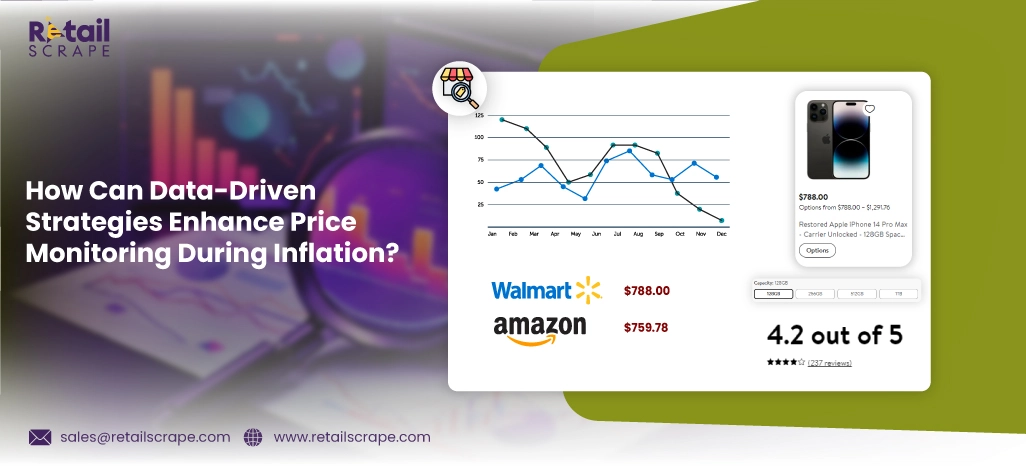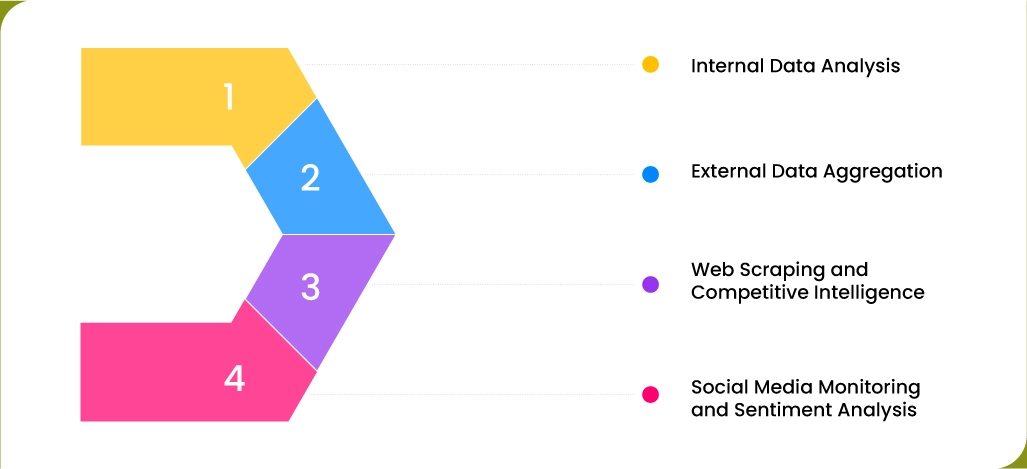
Introduction:
Inflation, the persistent increase in the general price level of goods and services over time, presents a formidable challenge for individuals, businesses, and governments on a global scale. Its far-reaching implications necessitate a nuanced understanding and proactive responses to mitigate its adverse effects. One such imperative response is effective price monitoring, the cornerstone of informed decision-making in inflationary environments. In this context, leveraging data-driven strategies emerges as a critical enabler for successfully navigating periods of inflation. This article aims to delve into the intricate dynamics of price monitoring during inflation and elucidate how businesses can harness the power of data to achieve precision in their monitoring efforts, thereby ensuring adaptability and competitiveness in volatile markets.
Understanding the Impact of Inflation:
To appreciate the significance of price monitoring strategies during inflation, it is essential to grasp the multifaceted impact of inflation on businesses. Inflation exerts downward pressure on the purchasing power of consumers, leading to a reduction in real income and discretionary spending. Consequently, consumer behavior undergoes significant shifts, with individuals prioritizing essential purchases and seeking alternatives to mitigate the impact of rising prices. Furthermore, inflation disrupts supply chains by inflating input costs and squeezing profit margins for businesses across various industries. In this challenging landscape, businesses must recalibrate their pricing strategies meticulously to sustain profitability amidst mounting cost pressures. Timely and accurate monitoring of price fluctuations is paramount in this context, as it empowers businesses to scrape price data, glean insights into evolving market dynamics, and make proactive adjustments to their pricing strategies in response to changing conditions.
Incorporating Data-Driven Strategies for Precise Price Monitoring:
In times of inflation, data-driven strategies give businesses a robust framework to conduct precise price monitoring initiatives. Companies glean invaluable insights into pricing trends, consumer behavior patterns, and competitor dynamics by delving into various datasets. This approach elevates the granularity and accuracy of price monitoring efforts and equips businesses with actionable intelligence to steer their decision-making processes effectively. Through rigorous analysis, organizations can identify subtle shifts in pricing dynamics, anticipate changes in consumer preferences, and respond swiftly to competitive maneuvers. Leveraging a sophisticated Price Monitoring Tool further enhances the effectiveness of these strategies, providing real-time data insights and facilitating informed decision-making in volatile market conditions.
Furthermore, leveraging data-driven approaches allows companies to personalize pricing strategies based on customer behavior and preferences. Businesses can tailor promotional offers and discounts by segmenting customers according to their purchasing habits and responsiveness to price changes to optimize revenue and enhance customer satisfaction. Moreover, continuous pricing data monitoring and analysis, facilitated by Price Data Scraping, enable companies to remain agile and adaptive in real-time. By setting up automated alerts and triggers, organizations can promptly detect deviations from expected pricing patterns and proactively address them, thereby maintaining competitiveness amidst fluctuating market conditions.
Key Data Sources for Comprehensive Price Monitoring:

Exploring Key Data Sources for Comprehensive Price Monitoring is crucial for businesses striving to maintain competitiveness in dynamic markets. Leveraging diverse datasets provides insights into pricing trends, consumer behaviors, and competitor dynamics, enabling informed decision-making and strategic pricing adjustments.
- Internal Data Analysis: Businesses can leverage their internal datasets, including sales transactions, inventory records, and historical pricing data, to discern patterns and trends in consumer demand and pricing behavior. By conducting rigorous analysis of internal data, businesses can identify opportunities for optimization and fine-tuning of their pricing strategies.
- External Data Aggregation: External data sources, such as market research reports, economic indicators, and industry benchmarks, give businesses valuable context and insights into broader market trends and competitive dynamics. By aggregating and analyzing external data, businesses can gain a holistic understanding of the prevailing economic landscape and make informed decisions regarding pricing adjustments. Additionally, utilizing a price data scraper allows companies to efficiently gather and incorporate real-time pricing data from various online sources, further enhancing their ability to stay abreast of market fluctuations and make timely pricing decisions.
- Web Scraping and Competitive Intelligence: Web scraping techniques enable businesses to extract real-time pricing data from e-commerce platforms, competitor websites, and online marketplaces. By monitoring competitor prices and market trends through web scraping, businesses can gain a competitive edge and identify opportunities to optimize their pricing strategies accordingly.
- Social Media Monitoring and Sentiment Analysis: Social media platforms are rich repositories of consumer sentiment and feedback regarding pricing changes and product offerings. Businesses can gauge consumer perceptions and preferences by employing sentiment analysis tools, informing their pricing decisions and promotional strategies.
Implementing Data-Driven Price Monitoring Strategies:

Implementing Data-Driven Price Monitoring Strategies is essential for businesses seeking to navigate market complexities precisely. By harnessing diverse datasets, companies can gain valuable insights into pricing trends, consumer behaviors, and competitor dynamics, empowering informed decision-making for sustainable growth.
Define Clear Objectives and KPIs: Establishing clear objectives and key performance indicators (KPIs) is foundational to the success of data-driven price monitoring initiatives. Businesses should articulate specific goals, such as optimizing profit margins or maximizing market share, and define metrics to track progress and evaluate performance.
Employ Predictive Analytics: Leveraging advanced predictive analytics techniques like time series analysis and machine learning algorithms enables businesses to forecast future price trends and anticipate demand fluctuations. By harnessing predictive analytics, businesses can proactively adjust their pricing strategies to preemptively respond to changing market conditions.
Implement Dynamic Pricing Mechanisms: Dynamic pricing mechanisms leverage real-time data and algorithms to adjust prices dynamically in response to changes in demand, competitor prices, and other market variables. By adopting dynamic pricing strategies, businesses can optimize pricing decisions and capitalize on revenue opportunities while maintaining competitiveness in volatile markets.
Monitor Competitor Activity: Continuous monitoring of competitor pricing strategies and market positioning is essential for staying abreast of industry trends and competitive dynamics. By tracking competitor activity through data-driven insights, businesses can identify pricing gaps, benchmark their performance, and devise strategies to differentiate themselves effectively.
Iterate and Refine: Price monitoring is an iterative process that requires ongoing refinement and optimization. By continuously analyzing data, soliciting customer feedback, and evaluating the efficacy of pricing strategies, businesses can iteratively refine their approaches and adapt to evolving market conditions.
Conclusion: In conclusion, effective price monitoring is indispensable for businesses seeking to navigate through inflationary environments successfully. By embracing data-driven strategies and leveraging the power of advanced analytics and insights, businesses can achieve precision and agility in their price monitoring initiatives. Timely and accurate monitoring of price fluctuations enables businesses to make informed decisions, optimize pricing strategies, and maintain competitiveness in volatile markets. In an era characterized by unprecedented data availability and technological advancement, businesses that harness the full potential of data-driven price monitoring will emerge as frontrunners in pursuing sustainable growth and resilience amidst economic uncertainties.
Transform your retail operations with Retail Scrape Company's data-driven solutions. Harness real-time data scraping to understand consumer behavior, fine-tune pricing strategies, and outpace competitors. Our services offer comprehensive pricing optimization and strategic decision support. Elevate your business today and unlock maximum profitability. Reach out to us now to revolutionize your retail operations!
